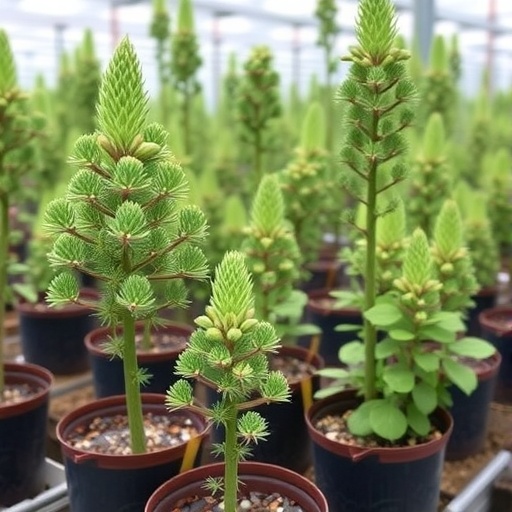In a groundbreaking study published in Discover Forests, researchers have delved into the complex web of relationships between seedlings of three different boreal conifer species. This initiative, spearheaded by a team led by renowned ecologists C. Marty, L. Baudry, and R.R. Paula, commenced in a controlled greenhouse setting designed to unravel the dynamics of intraspecific and interspecific interactions. This investigation stands to illuminate critical aspects of boreal forestry, with implications reaching from biodiversity conservation to commercial forestry practices.
This comprehensive experiment focuses on three conifer species native to the boreal biome: the Norway spruce, the Scots pine, and the Siberian larch. Boreal forests, known for their resilience and unique ecological functions, face numerous challenges due to climate change and human activities. Understanding the interactions among these conifers during their seedling phase can provide pivotal insights into forest health and regeneration capacity in changing climates.
The aim was to analyze how these species interact not only within their own kind, a principle termed intraspecific interaction, but also how they engage with one another, which is known as interspecific interaction. These relationships are crucial as they can determine growth patterns, nutrient acquisition, and resilience to pathogens and environmental stress. This information is vital for forest management strategies, particularly in replanting efforts following timber harvests and forest disturbances.
Researchers collected seedling samples from diverse environmental conditions to establish a well-rounded understanding of the species’ responses. Environmental factors such as soil type, moisture levels, and light availability were meticulously controlled within the greenhouse setting. This attention to detail ensured that the results would accurately reflect how these conifers might behave in their natural habitats while minimizing confounding variables.
The seedlings were subjected to a variety of treatments to observe their response to different competitive scenarios. For instance, in plots where seedlings of the same species were planted together, researchers could assess how individuals performed when surrounded by their kin. Meanwhile, mixed plots allowed scientists to observe the dynamics of competition when different species were pitted against one another. Such diverse experimental designs enabled the researchers to tease apart the complexities of plant interactions in real-time.
Interestingly, the results revealed distinct differences in growth patterns depending on the type of interaction. For instance, seedlings of Norway spruce demonstrated superior growth when nurtured within their own species as opposed to competing with Scots pine or Siberian larch. This trend raised questions regarding the adaptability and competitiveness of the species. It also illustrated how crucial such dynamics could be in determining which species might dominate in future forest compositions resulting from natural and anthropogenic influences.
Moreover, the study uncovered that Scots pine exhibited a fascinating ability to thrive even under interspecific competition from the other species. It seems to have developed strategies that allow it to utilize resources efficiently, which may be a significant factor in its widespread distribution across various boreal landscapes. Such resiliency under competitive conditions points towards its potential role in forest regeneration in disturbed environments.
In contrast, Siberian larch showed a somewhat mixed response. Under certain conditions, it demonstrated remarkable vigor while at other times lagged in growth, especially when competing with the more dominant Norway spruce. This variability raises crucial questions about the factors influencing larch’s performance and suggests that successful regeneration could hinge on understanding these interactions under fluctuating environmental conditions.
Beyond these interactions, the ecological implications of this research extend into the domain of forest ecology and management practices. The ability to predict which species will thrive under specific conditions could inform reforestation strategies, particularly in areas facing significant climate challenges. For instance, selecting the right combination of conifers for mixed-species plantations may improve ecosystem resilience and productivity.
This investigation also enhances our understanding of biodiversity and its significance in forest ecosystems. Biodiversity is not merely a feature of ecological richness; it is inherently linked to the productivity and sustainability of forest ecosystems. By establishing a nuanced understanding of species interactions, the research underscores the importance of conserving diverse conifer populations in boreal forests.
The greenhouse experiment’s meticulous design also serves as a model for future studies. It allows scientists to control various environmental parameters while exploring complex biological interactions, a feat that is often more challenging to achieve in natural settings. This research paradigm encourages a new wave of ecological studies aimed at uncovering the subtleties of plant interactions within myriad ecosystems.
As climate change continues to place pressure on forest ecosystems, understanding species dynamics will be imperative for both biodiversity conservation and forest management. This research paves the way for ongoing inquiries into how various species will cope with increasingly unpredictable environmental changes.
In sum, the pioneering work conducted by Marty, Baudry, and Paula represents a step forward in the realm of ecological research. Their findings are bound to resonate within the scientific community and ultimately inform practices aimed at sustaining forest health and biodiversity. With the continuous evolution of forestry practices, insights gleaned from such studies will be instrumental in crafting guidelines that not only preserve but also enhance the resilience of boreal forests in the face of adversity.
In conclusion, by unraveling the complex interactions among boreal conifer seedlings, this research offers a potential roadmap for future studies and practical forestry applications. It highlights the necessity of interdisciplinary approaches that blend ecology with forestry management, ensuring that our forests can thrive against the backdrop of an ever-changing climate.
Subject of Research: Intraspecific and interspecific interactions between boreal conifer species seedlings
Article Title: Intraspecific and interspecific interactions between three boreal conifer species seedlings: a greenhouse experiment
Article References:
Marty, C., Baudry, L., Paula, R.R. et al. Intraspecific and interspecific interactions between three boreal conifer species seedlings: a greenhouse experiment. Discov. For. 1, 30 (2025). https://doi.org/10.1007/s44415-025-00032-1
Image Credits: AI Generated
DOI: 10.1007/s44415-025-00032-1
Keywords: boreal conifers, intraspecific interaction, interspecific interaction, seedlings, forest ecology, biodiversity, greenhouse experiment, forestry management.




